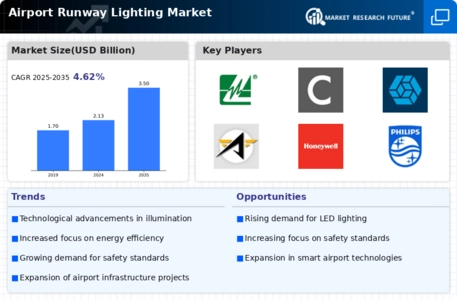Regulatory Compliance and Safety Standards
The Airport Runway Lighting Market is heavily influenced by stringent regulatory compliance and safety standards imposed by aviation authorities. These regulations mandate the implementation of advanced lighting systems to ensure safe takeoffs and landings, particularly in adverse weather conditions. Compliance with international standards, such as those set by the International Civil Aviation Organization (ICAO), is essential for airport operations. As a result, airports are increasingly investing in modern lighting technologies that meet these safety requirements. The emphasis on safety not only enhances operational efficiency but also fosters public confidence in air travel, thereby driving growth in the Airport Runway Lighting Market.
Investment in Airport Modernization Projects
The Airport Runway Lighting Market is bolstered by substantial investments in airport modernization projects. Governments and private entities are recognizing the need to upgrade aging airport infrastructure, including runway lighting systems, to enhance operational efficiency and safety. Recent reports indicate that global investments in airport infrastructure are projected to reach over USD 100 billion in the next decade. This influx of capital is likely to facilitate the adoption of advanced lighting technologies, thereby driving growth in the Airport Runway Lighting Market. Modernized lighting systems not only improve safety but also enhance the overall passenger experience, making them a critical focus for airport authorities.
Increasing Air Traffic and Airport Operations
The Airport Runway Lighting Market is significantly influenced by the rising air traffic and the consequent expansion of airport operations. As air travel continues to grow, airports are compelled to enhance their infrastructure, including runway lighting systems. According to recent data, air traffic is expected to increase by 4.5% annually, necessitating upgrades to existing lighting systems to accommodate larger aircraft and increased flight frequencies. This surge in demand for efficient and reliable runway lighting solutions is likely to propel market growth. Airports are investing in modern lighting technologies to ensure safety and compliance with international standards, thereby driving the Airport Runway Lighting Market forward.
Technological Advancements in Lighting Systems
The Airport Runway Lighting Market is experiencing a notable shift due to rapid technological advancements. Innovations in lighting systems, particularly the integration of LED technology, have enhanced visibility and reduced energy consumption. The market is projected to grow at a compound annual growth rate of approximately 6.5% over the next five years, driven by the demand for more efficient and sustainable lighting solutions. Furthermore, the introduction of smart lighting systems, which can adapt to weather conditions and operational needs, is likely to improve safety and operational efficiency at airports. These advancements not only contribute to cost savings but also align with environmental sustainability goals, making them a pivotal driver in the Airport Runway Lighting Market.
Sustainability Initiatives and Environmental Concerns
The Airport Runway Lighting Market is witnessing a shift towards sustainability initiatives driven by growing environmental concerns. Airports are increasingly adopting energy-efficient lighting solutions, such as LED systems, to reduce their carbon footprint. The transition to sustainable lighting technologies is not only beneficial for the environment but also results in significant cost savings over time. As regulatory bodies and stakeholders emphasize the importance of sustainability, airports are compelled to invest in eco-friendly lighting solutions. This trend is expected to accelerate the growth of the Airport Runway Lighting Market, as more airports seek to align their operations with global sustainability goals.


















Leave a Comment